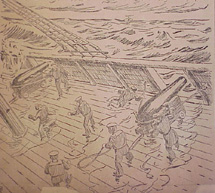 | |||||||||||||
| |||||||||||||
The War at SeaNaval power was an important factor in the Union's victory over the Confederacy. The U.S. Navy was relatively small at the beginning of the war, but expanded rapidly through construction and leasing of hundreds of vessels. Changes in technology resulted in new types of ships, most famously the Monitor, the first ironclad warship in the U.S. Navy. President Abraham Lincoln announced a blockade on Southern ports on April 19, 1861 for the duration of the war. Known as the Anaconda Plan, General Winfield Scott's plan was to starve the South by strangling 3,000 miles of the Atlantic and Gulf coasts, and the Mississippi River, surrounding it like a giant snake. Southern blockade runners operated throughout the war, bringing goods to the South. Although it was not particularly successful at first, over time the blockade did have an effect, and arguably helped the North win the war. This illustration portrays the fleet off Cape Hatteras attempting to rescue a man overboard. For more about the U.S. Navy and the Monitor, see Documents 34, 35, 36, and 37. Citation - Document 32 Additional Documents:
|
|||||||||||||
